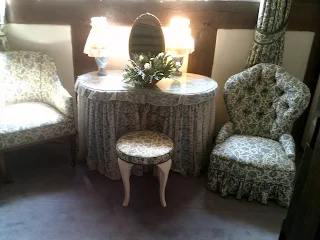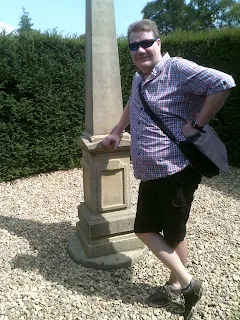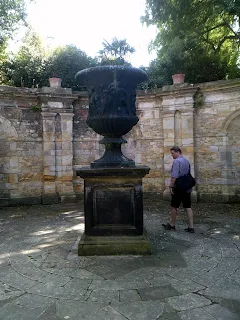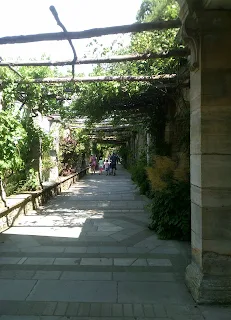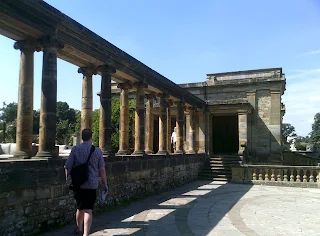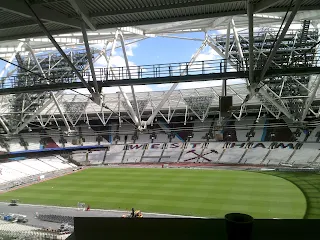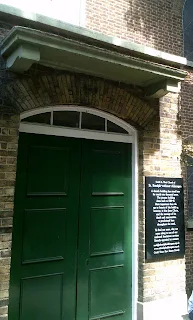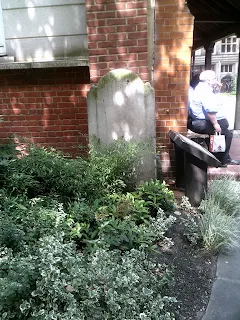After a very stressful July (career issues and trying to fit too much in) which led to me feeling on the edge of a nervous breakdown, behaving out of character, having four separate meltdowns and doing too much drinking on an empty stomach, it was decided that my actual birthday would be a quiet one, with a relaxing day at home followed by local-ish pizza in Romford.
One of my meltdowns involved a lump of a man having a go at me in Westfield Stratford, so I threatened to stick his walking stick up his arse and turn him into a human kebab. If I've offended anyone recently then, quite frankly, BALLS! Self-love (no, I don't mean masturbation!) and taking care of my mental health has recently become very important to me and I'm putting my needs first. I'm not a bad person- just one with shattered nerves.
But the following day I put into action what would have been my birthday day out, and visited Hever Castle in Kent. It was an easy train ride from London Bridge followed by a short wander down country roads which had no pavements. Although the roads were quiet I found this very unpleasant, but I remembered my country code and just got on with it.
Here is my first view of the castle...
The striking Topiary Walk to the castle contains many yew hedges trimmed into weird shapes...
Approaching...
From more of a distance, taken on the Rhododendron Walk...
Including the Astor Wing, which is in the Tudor Village (added after 1903) to the left. It is available for private hire...
I first became interested in visiting the castle after seeing it repeatedly on television history programmes. I saw the splash of blood red on the front of the building and was intrigued (and very excited) when a bit of googling gave me its name and a location that's not too difficult for me to get to.
I expected the castle to look like this PDF below but, apparently, the Boston ivy on the front only turns red during autumn time. Aha! There's my excuse to come back sorted!
Hever Castle has a history dating back more than 700 years. The original medieval defensive castle was built here in 1270 and, in the 15th and 16th centuries, was the home of one of the most powerful families in the country- the Bullens. Hever's most famous occupant was Anne Boleyn. Her family name was Bullen, but there were no set spellings in Tudor times and few people could read and write, so she chose to sign herself Boleyn, probably from the more sophisticated sounding French pronunciation.
Anne of Cleves, Henry VIII's 4th wife, was granted Hever Castle as part of her divorce settlement, then the house was in the Waldegrave family for over 158 years; longer than any other owner of the castle.
The Astor family were the owners from 1903. William Waldorf Astor was the great-grandson of Johann Jakob Astor, a German emigre and founder of the Astor empire- when he died, in 1848, he was the richest man in America- and was responsible for restoring the castle.
It's interesting that, like Eltham Palace, it's new money which stopped the castle from falling into decline. Since 1983, the whole property has been in the ownership of private company Broadland Properties Ltd. It is not part of English Heritage and is independently run.
You walk into this courtyard, which I found delightful...
Here you can see the Boston ivy beginning to change colour...
The Inner Hall was the Great Kitchen during Tudor times...
Fireplace and a nosey SuperDean...
Balcony and ceiling. These photos aren't great as flash photography wasn't allowed.
The Drawing Room, created by William Waldorf Astor. The Astors were renowned for their hospitality and it's in here that their guests would have been served drinks before dinner.
The Dining Hall, which was the Great Hall during the Bullen's time...
Henry VIII was worried about assassination so, to ensure his safety when visiting other houses, he brought his personal locksmith to fit a special door lock to his bedchamber. This lock is now on one of the Dining Hall doors.
I had to play with this in Photoshop as it was quite dark in this room and the photo did not come out well...
This PDF might be a bit more explanatory...
The Entrance Hall...
The Library...
From the window you can see Anne Boleyn's Orchard. It was a boiling day and the recent hot, arid weather had dried everything out to a shade of yellow...
The Morning Room. I'm sure they're not, but these chairs looked positively unstable!
The Catholic Waldegrave family incorporated a 'priest hole' into this room. It sits to the left of this photo and is now a china cabinet. One ghostly Hever tale suggests that a priest died in here and that his unhappy spirit still lingers.
Anne Boleyn's Bedroom (or so it is traditionally thought to be). She may have shared it with her sister, Mary.
Here is the bedhead with 'Part of Anne Boleyn's bed from Hever 1520' carved on it. It doesn't seem to date before 1600 and was probably a made-up piece, following a revival of interest in Anne during Victorian times.
This lovely stained glass window was inside the corridor...
The Book of Hours Room displays two prayer books, which belonged to Anne. Again, the lack of a flash has made for a mediocre photograph...
This tapestry is on the wall...
The Queens' Chamber displays portraits of all of Henry VIII's six wives, as well as this one of the man himself, over the fireplace...
The Staircase Gallery was created by Thomas Bullen in 1506, over the Entrance Hall, to give access between the two wings of the house...
I took this view out over the ivy courtyard from this room...
King Henry's Bedchamber. It's actually impossible to know which room he slept in when he visited the castle. However, this is one of the largest bedchambers in the castle.
The Waldegrave Room...
After Protestant Elizabeth I came to the throne in 1558, this small chapel (or oratory) was built, hidden behind panelling so that Sir Edward Waldegrave could practice his faith in secret.
Another view from a window, this time overlooking the Tudor Garden...
The Long Gallery runs the entire width (98 ft) of the building. It was created in 1506 by Thomas Bullen, who put a ceiling over the Great Hall below. The Great Hall had previously been open to the rafters.
The Astor Suite is dedicated to more recent history. The Astors restored, added to and enhanced the existing rooms, using their vast wealth to do so. They were also responsible for modernising the castle; adding plumbing and electricity, although light switches and pipes are carefully concealed.
These bedrooms were created in 1968 for the three daughters of the house. They each chose their own decor and the rooms were affectionately known by the family as the 'Dog Kennels'.
These stairs were a little precarious and I had to concentrate hard not to trip as I was wearing (sensible yet blingy) mules!
The Gatehouse is the oldest part of the castle. These throne-like chairs illustrate how, during the 13th century, the Lord of the Manor would have used the room for meetings and dispensing justice when it was used as a Council Chamber.
There were also instruments of torture in this room, but instead I took a photo of the garderobe, which emptied directly into the moat...
I had a chortle with another visitor at this self-explanatory picture!
Back outside, there are koi carp in the moat...
We tackled the maze...and won! Here's the SuperDean at the centre...
I've always loved weeping willow trees...
Half Moon Pond...
This water maze spouts unexpected jets of water at you when you tread on certain stepping stones. It was actually very refreshing to get a soaking on this scorcher of a day.
Cascade...
An urn at the beginning of the Long Border...
View from one urn to another...
Walking down the Long Border...
I thought this topiary tree was delightful...
The Italian Garden was crying out for rain!
The Rose Garden...
The Lake and Boathouse. It was too hot to complete a full circuit of the lake.
The Lake...
Loggia and Piazza...
The Sunken Garden...
The corresponding urn...to the one I saw earlier...
Another urn; this one was overlooking the section of lake that had the Water Maze at the other side...
There was a good shop with a section which housed an exhibition of miniature model houses, so we took a look at that and then left.
We took a shortcut back to the station, via a rustic path which ran beside a field. I managed to get a splinter in my toe and had to climb over a stile, and a two tier stile at that, rather like the one in the PDF below. I said, 'I don't do stiles- I'm a city girl!' But I was brought up in a rural area so it's not something I'm unfamiliar with, and I just got on with it.
Oh well, I only had the sheep in the neighbouring field to laugh at me making my cumbersome way over said stile!
This is called Laughing Flock, and is by an artist called Scott Gustafson.
Hever Castle, I will return- if only to see the Boston ivy when it's red, and take a full walk around the lake.
TTFN
The Miss Elaineous
XXXXXXXXXXXXXXXXXXXXX
XXXXXXXXXXXXX






































